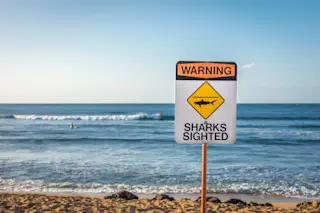On the third Friday of December 2021, an orange-on-black LED construction sign displayed an ominous message to beach-goers in Morro Bay, California. “FATAL SHARK ATTACK,” the sign stated simply. Earlier that day, someone had spotted a large object floating in the water. The object was a man, and the man had been attacked by a great white shark while boogie boarding. He was pronounced dead at the scene.
While movies like the 1970s thriller Jaws have made shark attacks a pervasive phobia in the American collective subconscious, the truth is that they are extremely rare. Before the boogie boarder was discovered in Morro Bay, it looked like the U.S. might have a shark fatality-free year. And it wouldn’t have been an unusual occurrence — 2014, 2016 and 2017 saw no fatalities.
Of course shouting these statistics at a terrified Midwesterner who is white-knuckling a surfboard during their first trip to ...















